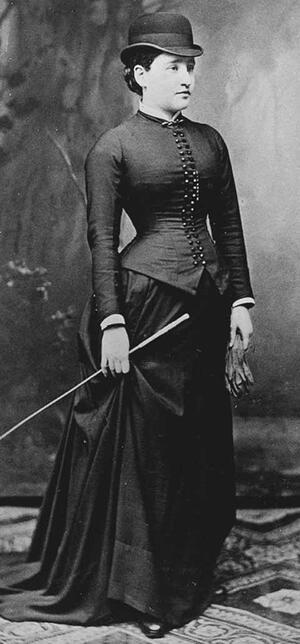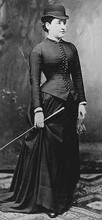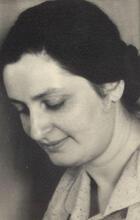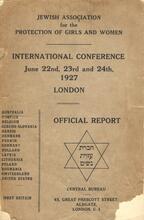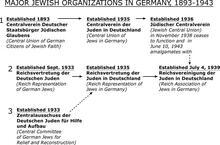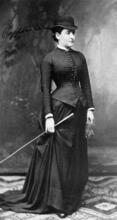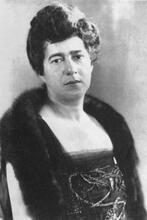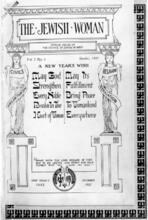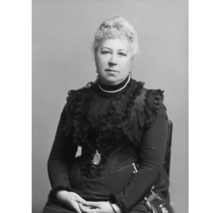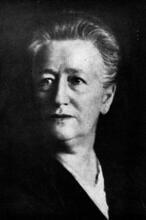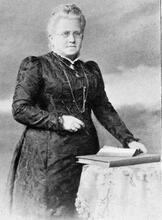White Slavery
“White slavery traffic” was an expansion of the prostitution that spread throughout the world in the first years of the twentieth century, following the massive emigration to the New World and resulting from the growing poverty and misery of European women in the age of industrialization. Those who initiated the struggle against white slavery in Europe and America were mainly women. Among them were leading Jewish women's organizations (from the United States, England, and Germany); they established committees against “white slavery” in several countries, sending representatives to the international conferences combating trafficking in women and girls: in Paris in 1902, Madrid in 1910, and London in 1913. All these struggles have led to significant anti-trafficking legislation during that time.
Introduction
“White slavery traffic” was in part an extension of the prostitution that spread throughout the world in the nineteenth century, following the beginnings of massive emigration to the New World. It was also a result of the growing poverty of European women in the age of industrialization that continued in the next century. Large European cities such as Paris and London housed thousands of prostitutes and governments did nothing to contain the problem, contenting themselves with preserving public order and ordering medical inspections to reduce the risk of venereal disease. The women had to undergo medical examinations and register as prostitutes, while the men who were consumers of their sexual services were not required to undergo any examinations and were immune to legal prosecution.
The enormous spread of prostitution in Europe, and specifically its transformation into an international trade over the second half of the nineteenth century, can be attributed to several factors, including:
- The great distress of women who entered the workforce en masse, under terrible conditions, during the Industrial Revolution;
- The migration from villages to cities, which caused both difficulties in adapting and a loss of direction, especially for vulnerable women who had no status;
- The migration of men from Europe to the New World, which created large concentrations of men and led to the increased demand for prostitutes in those locations;
- The delayed marriage of bourgeois men until they had sufficient resources to support a family. Because gender norms of bourgeois society did not permit sexual relations outside marriage with women of their own class, single young bourgeois males turned to prostitutes.
The public panicked when newspapers reported kidnappings of women and wrote of young girls who were forced into prostitution under false pretenses and taken to brothels in distant countries. Committees and international meetings were held in various places in the world to place the subject on the public agenda and seek ways of combating the phenomenon. This form of prostitution, called at the time “white slavery,” was considered different from voluntary prostitution, given its severity and cruelty.
The silence was broken for the first time in England by Josephine Butler (1828–1906), the daughter of an Anglican abolitionist minister, who beginning in 1864 led a campaign against the regulation of prostitution, which she deemed immoral. Believing that the government should concern itself with the social and economic causes of prostitution, Butler founded the Ladies National Association (LNA) and the International Abolitionist Federation to fight prostitution in 1875. In the late nineteenth century, when international traffic in prostitutes was organized, using corrupt means and often working clandestinely, Josephine Butler’s organization set up national committees to work against white slavery in the capitals of Europe, Egypt, Canada, the United States, South America, and South Africa.
In England, the campaigns against “white slavery” culminated in a rally in Hyde Park, London, in August 1885, when tens of thousands of people demanded that white slavery be outlawed and the age of consent for girls be raised. The first measure to be adopted was the Criminal Law Amendment Act (CLAA) of 1885, which gave a definition of a trafficked girl: an involuntary prostitute.
In the United States, the term “white slavery” had been used since the seventeenth century to refer to a wide range of exploitative labor practices. By 1907, it emerged as a serious mainstream human rights issue against sex trafficking, described by the press as a form of hysteria. In fact, the period between 1907 and 1914 corresponded to a period of widespread immigration to the United States that generated considerable fear and anxiety, especially in response to stories about sex traffickers using marriage as a method to entrap their victims, as well as other methods
Jewish Prostitution and Trafficking in Women
Jewish trafficking in women did not begin in a vacuum. Jews joined the crime wave that swept East European Jewish society and spread throughout the world. Prostitution and international trafficking in women, among the gravest plagues in Western society from the end of the nineteenth century on, did not bypass Jewish society, which had been undergoing enormous changes since the 1880s. The migration from town to city and the increase in poverty contributed to the development of prostitution among Jews. Most big cities that contained large, poor populations of Jews (Warsaw, Odessa, Vilna, Cracow, Budapest, and Vienna, for example) saw concentrations of Jewish prostitutes working in brothels for Jewish pimps. It was virtually impossible to work as a prostitute in small towns and shtetls where everyone knew everybody else and prostitutes were ostracized. In large cities, prostitution took place in certain sections known to be controlled by the Jewish underworld, to which the authorities turned a blind eye. Between 1872 and 1890 Jewish women constituted seventeen to twenty-three percent of all Warsaw’s registered prostitutes, who in 1890 numbered 962. At the time, the Jewish population (c. 300,000) constituted one-third of the city’s total population (Bristow 55). In 1908, the American consul in Odessa reported that “All the business of prostitution in the city is in the hands of the Jews” (Bristow 56). In Minsk in 1910, 226 women were registered as prostitutes, 67 of whom were Jews. On the other hand, it was reported that half the prostitutes hospitalized for venereal disease in the city were Jews (Bristow 64).
In addition to the general causes of prostitution, such as economic distress, loss of parental authority, and the weakening of the family as a result of poverty, two additional factors were specific to Jews: antisemitic persecution and the restrictions placed on Jews. These caused overcrowding, poverty, and unemployment, creating a fertile environment for crime among unemployed men, while a number of young Jewish women found refuge from economic distress by working as prostitutes. In Russia, where Jews were generally permitted to live only in restricted areas (the Pale of Settlement), a Jewish woman registered as a prostitute could receive a permit to remain in a city such as St. Petersburg. Paradoxically, it was this badge of shame that allowed poor Jewish women an existence beyond hunger and poverty. Some of the registered Jewish prostitutes were not destitute, rather seeking permits to live in St. Petersburg or Moscow in order to acquire higher education.
However, the increase in prostitution among Jews stemmed mainly from the large waves of migration that occurred among Jews in Eastern Europe, beginning in 1880. Over approximately sixty years, millions of Jews endured wandering, hardship, separation of families, loss of direction, and a break in tradition.
Jewish Sex Traffickers
Since unscrupulous Jews active in the underworld were familiar with the customs and traditions of Jewish society, they knew how to exploit the innocence of young Jewish girls. The inferior status of Jewish women combined with Jewish religious law to render them especially vulnerable and contributed to their falling into the hands of sex traffickers. Sex trafficking, which developed in the surrounding society, drew Jewish criminals into profitable sex deals. Several contented themselves with local deals, while others exported prostitution to distant lands. While many young women were brought into prostitution unwittingly, some worked as prostitutes in their home towns and hoped to improve their fortunes in richer countries. Most of these willing prostitutes were also victim to the false promises of their pimps, finding themselves in an inferior position in a foreign country, not knowing the language and completely dependent on their pimps because of the debts they had accumulated.
To entice their victims, Jewish sex traffickers used newspaper advertisements for jobs, the promise of an immigration certificate, and marriage proposals, all the while taking advantage of the parents’ naiveté and poverty. They knew, for example, that a Jewish wedding requires two witnesses and a ring and that a rabbi is not necessary. The “secret wedding ceremony” became one of the methods for bringing Jewish women into prostitution. One trafficker managed to marry a record twelve women and send them into prostitution (Bristow 104).
The second evil was the problem of Woman who cannot remarry, either because her husband cannot or will not give her a divorce (get) or because, in his absence, it is unknown whether he is still alive.agunot (anchored wives). Women whose husbands died without witnesses or went missing without leaving a writ of divorce became agunot—with no status, helpless and vulnerable to trafficking. Many husbands who went on journeys without their wives in order to try their luck in America “forgot” to send their wives any sign of life. Others never returned from war, but their deaths could not be proven.
Before World War I, the National Desertion Bureau was established in New York to search for delinquent husbands. In 1929 the World Jewish Women’s Congress in Hamburg, Germany, reporting on 25,000 agunot in greater Poland alone, described the situation as the catastrophe of Eastern European Jews (JTA Bulletin, June 26, 1929).
Jewish sex traffickers were prominent in major transit points from Europe to Latin America, such as Berlin, London, and Hamburg. In the latter, for example, of 402 sex traffickers caught by police in 1912, 271 were Jewish (Bristow 52–53). Although the facts speak for themselves, there was also a tendency to exaggerate the percentage of Jewish sex traffickers and Jewish prostitutes because it was easier to condemn an entire group, especially if they were Jews. At a time when antisemitism was increasing throughout the world, reports of the involvement of so many Jews in such shady dealings caused a great deal of damage to the image of Jews and were used by antisemites. Jewish communities found it difficult to deal with this embarrassing problem and for a long time ignored it, until newspaper reports forced them to confront it.
The problem of prostitution among Jews began in Eastern European countries and spread throughout most of the world in which trafficking in women existed. The Jewish prostitution networks recruited young women in Eastern Europe and brought them via transit stations across Europe to various destinations throughout the world. Preferred destinations were South America (Buenos Aires , São Paulo, Rio de Janeiro), the United States (New York, Chicago, Philadelphia), South Africa, Turkey (Constantinople), and Egypt. In addition to their moral outrage over the phenomenon itself, the local Jewish communities suffered greatly from the stigma that resulted from Jewish involvement in prostitution. The chief method they used to fight traffickers and prostitutes was ostracism. The “impure ones,” as they were termed, were not permitted entry into the community’s synagogues or burial in its cemeteries. In Buenos Aires, traffickers in women formed their own society, Zwi Migdal, which established its own synagogues and cemeteries.
Beginning in 1910, after years of apathy and denial, most important Jewish organizations established committees against “white slavery,” sending representatives to international conferences on the topic. The severity of the situation and the official statistics of Jews involved in criminal activity made it impossible to continue to ignore the issue. Yet before the Jewish organizations were forced to intervene, well-to-do Jewish women did a great deal to convince Jewish community leaders of the severity of the problem. They prepared the ground, organizing an infrastructure of wide-scale activity to protect immigrant Jewish women and young girls from the dangers that lay in wait for them.
Jewish Women Against Sex Trafficking
During the nineteenth century, women developed a wide network of charitable and social work. According to a census in Great Britain in 1891, over 500,000 women were involved in philanthropic work (Hubbard 361–366). At the same time, a change developed in the attitude toward the poor. In the past, charity had been considered a religious duty and poverty connected with moral decline. Now, a more complex analysis of the reasons for poverty and a new kind of social involvement came into being. Monetary donations were no longer enough; personal involvement was necessary. This involved home visits, visits to prisoners, prisoner rehabilitation, adult education, and so on. Beginning with the waves of immigration of 1881, the women activists turned their attention to social work on behalf of immigrant girls and the subject of white slavery. Christian women’s organizations were founded to protect young immigrant women. Some of these had names such as the International Catholic Girls’ Protection Society and the Travelers’ Aid Society.
Well-to-do Jewish women could not join the Christian charitable organizations of the surrounding society, nor could they participate in the leadership of Jewish organizations, which were headed by men. Therefore, like their Christian neighbors, they decided to form their own organizations to help their needy co-religionists. Established at the end of the nineteenth century, these organizations became stronger during the twentieth century, contributing to the entry of women into public life and their participation in various significant social struggles
Jewish women involved in public activity encountered the subject of white slavery for the first time in international committees of women’s organizations and in committees on trafficking in women. They were horrified to hear statistics about Jewish involvement in crime and about the unprecedented number of Jewish women involved in prostitution. Several leaders who headed the public and social struggle on behalf of women in distress in Europe and in immigration destinations such as the United States were among the first to deal with the problem in a practical way. These pioneers included Constance Rothschild, Lady Battersea, of Great Britain, Bertha Pappenheim of Germany, and Sadie American of the United States. They influenced Jewish women in other countries to join the struggle against trafficking in women in the Jewish world, though at first they encountered opposition from community leaders, mainly Orthodox men and rabbis who were repelled by the subject.
Great Britain
Though the struggle against the institution of white slavery existed in Great Britain from the beginning of the nineteenth century, for a long time the Jewish community ignored the concentration of Jewish prostitutes in the immigrant district of London. In 1885, when Constance Rothschild, Lady Battersea, the daughter of Anthony de Rothschild (1810–1876), first learned about the grave situation of immigrant Jewish women in her city, she decided to act, first establishing a shelter for Jewish women in distress. Through this shelter, women received immediate aid, instruction in English, and professional training. In the same year Lady Battersea Rothschild established the Jewish Association for the Protection of Girls and Women (JAPGW). To give more status to the new organization, she recruited to its leadership such well-known Jewish community leaders as Claude Joseph Goldsmid Montefiore (1858–1938) and Artur Moro, who were also her relatives. In 1889, when London became a transit point for masses of Jewish immigrants from Eastern Europe, and as a result a center for traffickers in women, Constance Rothschild Battersea decided that the situation was severe enough to warrant the supervision of the leaders of Jewish communal institutions. The women continued to take the rescue and aid work upon themselves.
The JAPGW was later supported by the Jewish Colonization Association (JCA), though the JCA hesitated a great deal before agreeing to become involved in the fight against sex trafficking in the Jewish world. Like other Jewish organizations, it feared to associate itself so closely with a topic so loaded with negative connotations that could harm its image. Later it developed a wide-scale apparatus for preventing crime and assisting organizations that aided young women in distress.
France
From 1910 on, many other Jewish organizations became involved in combating white slavery. For example, the French Association israélite de protection de la jeune fille (Jewish Association for the Protection of Young Girls) was founded in 1910 by a group of Jewish ladies. Confronted with the sensitive subject of white slavery, the French Jewish community had long hesitated to deal with it officially, motivated by fear of antisemitism following the Dreyfus Affair. The new organization was supported first by the Jewish Colonization Association and the JAPGW, but not yet by an official body of the French Jewry. Its first president was the prestigious baroness Adélaïde de Rothschild, wife of the famous philanthropist Edmond de Rothschild, but it seems that the focus of the Association israélite was more on helping isolated girls in difficulty, Jewish and non-Jewish, through social assistance, moralizing, and educating, rather than fighting trafficking on women.
Germany
Unlike Great Britain, where women passed the struggle to men, contenting themselves with the practical work of aid and rescue, Jewish feminists in Germany placed themselves at the center of the fight against sex trafficking.
The major initiator was Bertha Pappenheim, who came from a well-to-do Orthodox family in Germany and was active in Jewish feminist organizations. She first learned of Jewish involvement in prostitution in 1902 at an international meeting on sex slavery. From then on she participated fully in the struggle against this plague, which she felt had its origins in poverty, ignorance, and the inferior status of Jewish women as expressed mostly in the laws of marriage and divorce. She was repelled by the stigma of the “old maid,” which was considered a family disaster among Jews, and by the tendency of Jewish families to shun daughters who had strayed from the path, committing even one transgression. She believed this led many women to despair and thus to fall prey to sex traffickers.
Pappenheim visited many places where white slavery was flourishing, including Galicia, Russia, Hungary, Bulgaria, the Balkans, Palestine, and Egypt, to study the subject close up and to raise the attention of Jewish communities to the necessity of keeping young Jewish girls from degradation. She wrote her impressions in letters sent from the places she visited (1911–1912), published in a book entitled Sisyphus-Arbeit (1911), where she related how she tried desperately to inform Jewish communities of the gravity of the situation. She asserted that the silence of Jewish community leaders, who claimed they feared antisemitism to justify their non-intervention, was actually a kind of collaboration with the crime. The Jüdischer Frauenbund, which she established in 1904, unified most of the Jewish women’s organizations in Germany. Within several years it became one of the largest Jewish women’s organizations in the world, numbering 50,000 members in 1920. It worked a great deal against trafficking in women, mostly through prevention. It supported the establishment of girls’ schools in Poland, sent letters to Jewish families, circulated flyers warning them against job offers in newspapers and arranged marriages abroad, established aid stations in ports and railway stations in European cities, where volunteers wearing the Magen David symbol guided unaccompanied girls, and established clubs and shelters for women in distress. For close to twenty-seven years Bertha Pappenheim ran a shelter, one of the largest in Europe, in Neu-Isenburg, near Frankfurt, for single mothers in distress and their children.
The United States
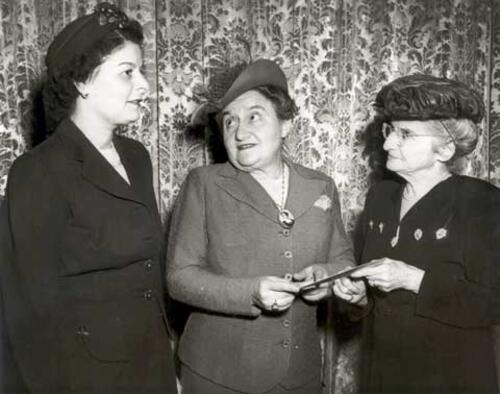
Cecilia Razovsky (center) spent her life striving to assist immigrants in adapting to life in the United States and other countries. She was an influential member of many organizations, including the National Council of Jewish Women. Her writing on and study of immigration issues helped to define elements of United States policy.
Institution: American Jewish Historical Society
The periodic international conferences to which representatives of Jewish women’s organizations were invited provided an opportunity for them to exchange opinions and information regarding the vital issues of the various Jewish communities. At one such conference, the American delegates were convinced that they must take an active part in helping Jewish women immigrating to the United States, who were helpless and vulnerable to white slavers.
Criminal activity of all sorts developed in New York City, where tens of thousands of Jewish immigrants lived. There are accounts of Jewish prostitutes who were found and arrested in New York. As in Buenos Aires, the New York community dealt with the struggle by shunning the “impure ones.” While this tactic perhaps saved the community’s reputation, it did nothing to solve the human problems that led so many Jewish women into prostitution.
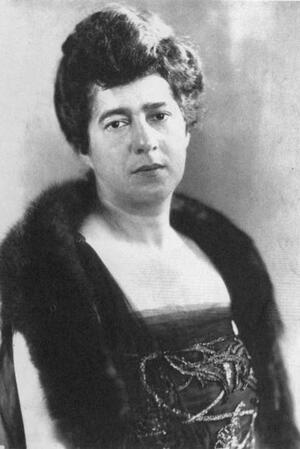
President of the National Council of Jewish Women from 1920 to 1926, Rose Brenner (1884-1926) provided strong leadership, almost doubling the size of the organization. The NCJW has always championed both public service and the role of traditional motherhood; indeed, Brenner is the only unmarried woman ever to be president.
Institution: The Jacob Rader Marcus Center of the American Jewish Archives, Cincinnati, OH, www.americanjewisharchives.org and Bachrach.
The National Council of Jewish Women in America (NCJW) led by women such as Sadie American, Rose Brenner, and Cecilia Razovsky, developed wide-scale rescue activity for immigrant Jewish women. Volunteers who received lists of young immigrant women made sure to meet them at the port and bring them to one of the guest houses that had been established in various cities, where they received professional training and the help they needed to settle in their new country. Between 1908 and 1911 the organization helped 19,377 young girls, 4,020 women, and 6,427 children (Baum et al. 51). Thanks to this wide-scale activity, the NCJW won prestige and great appreciation from women’s groups in America and Europe and received governmental recognition for its work at the port of New York. In 1910, at the international conference against white slavery in Spain, Sadie American was welcomed by the king and queen of Spain, who praised her for her organization’s work (Baum et al. 166).
The cooperation of women’s organizations in Great Britain, Germany, and the United States regarding sex trafficking prepared them to strengthen their contacts and unite their forces and contributed to the establishment of international Jewish women’s organizations throughout the world (Las 1996). Jewish women’s organizations were active in Cracow, Riga, Latvia, Hungary, Warsaw, and most places where women were at risk. Each organization worked according to its ability and initiative. Some offered courses in literacy and sewing and professional training for women or opened women’s employment bureaus. They sent volunteers to transit stations to help needy women and published warnings against white slavers, and some even volunteered to search for absent husbands.
Two impressive international conferences of Jewish women took place in the 1920s, one in Vienna in 1923 and the other in Hamburg in 1929. They discussed all the problems and difficulties of the Jewish people at the time, including the distress of Jewish women, white slavery, and the problem of agunot (JCB News Bulletin, London, May 1923). The needs of the time and the amount of distress among Jews required international coordination and cooperation, but the women’s organizations did not have the means that the well-established, powerful Jewish organizations possessed. Nevertheless, through daring and determination they succeeded in building an infrastructure of mutual aid, rescuing thousands of Jewish women from moral degradation and suffering.
Apart from these impressive international Jewish women's meetings, the leading Jewish women's organizations (from the United States, England, and Germany) were involved in the general struggle against international trafficking and participated in all the international conferences combating trafficking in women and girls: in Paris in 1902, Madrid in 1910, and London in 1913.
These civil society international conferences were followed by official governmental international cooperation in the fight against sex trafficking. After World War I, the agreements would come under the umbrella of the League of Nations, which became the preeminent site of anti-sex trafficking activism during the interwar period. The first half of the twentieth century saw a number of international conventions regarding white slave traffic:
- International Agreement for the Suppression of the “White Slave Traffic,” Paris, 1904
- International Convention for the Suppression of the White Slave Traffic, Paris, 1910
- International Convention for the Suppression of the Traffic in Women and Children, Geneva, 1921
- International Convention for the Suppression of the Traffic in Women of Full Age, Geneva, 1933
- Convention for the Suppression of the Traffic in Persons and of the Exploitation of the Prostitution of Others, Lake Success, NY, 1950
(Note: The 1921 Conference of the International Bureau for the Suppression of the Traffic in Persons dropped the term "white slavery" for the less loaded term "traffic in women and children.")
Conclusion
The difficulty in coping with so grave a phenomenon did not prevent innumerable activists from devoting themselves to fighting it with all the energy they possessed. Those who initiated the struggle against white slavery in Europe and America were women. For Jewish women, this was their first attempt to cope publicly with a social issue that had such broad implications. They were the ones who succeeded in overcoming the shame and discomfort inherent in the subject of prostitution; they were the ones who initiated effective rescue and prevention work. Thanks to them, thousands of young Jewish women were saved from prostitution. We must remember that during this period women had no political rights in most countries in the world, and their ability to influence was confined to volunteer work and women’s organizations. At a time when Jewish community leaders hesitated to get involved and were afraid to mention the problem of prostitution, women took part in international conferences against the enslaving of women, where they had to confront embarrassing statistics regarding Jewish involvement in sex trafficking. They proved their ability to deal with this severe ethical and human problem despite the restrictions under which they had to function.
Bartley, Paula. Prostitution: Prevention and Reform in England, 1860–1914. London: Routledge, 2000.
Baum, Charlotte, Paula Hyman, and Sonya Michel. Jewish Women in America. New York: The Dial Press, 1976.
Bristow, Edward J. Prostitution and Prejudice: The Jewish Fight against White Slavery, 1879–1939. Oxford: Schocken, 1982.
Butler, Josephine E. Personal Reminiscences of a Great Crusade (Westport, Connecticut: Hyperion Press, 1911)
Cordasco, Francesco. The White Slave Trade and the Immigrants. Detroit: Blaine/Ethridge Books, 1981.
Gartner, Lloyd P. “Anglo-Jewry and the Jewish International Traffic in Prostitution, 1885–1914.” AJS Review 7–8 (1983): pp. 129–78.
Goren, Arthur. New York Jews and the Quest of Community. New York: Columbia University Press, 1979.
Hubbard, Louis. Statistics of Women’s Work. London: 1893.
JCB News Bulletin, London: May 1923.
JTA Bulletin, June 1929.
Kaplan, Marion. The Jewish Feminist Movement in Germany: The Campaigns of the Jüdischer Frauenbund, 1904–1938. London: Praeger, 1979.
Knepper, Paul. “’Jewish Trafficking’ and London Jews in the Age of Migration.” Journal of Modern Jewish Studies 6 (2007): 239–56.
Kuzmack, Linda Gordon. Woman’s Cause: The Jewish Woman’s Movement in England and the United States: 1881–1993. Columbus, Ohio: Ohio State University Press, 1990.
Las, Nelly. Jewish Women in a Changing World: A History of the International Council of Jewish Women (1899–1995). Jerusalem: Hebrew University of Jerusalem, 1996.
Las, Nelly. “Prostitution and White Slave Traffic in Jewish Society at the Beginning of the Twentieth Century” (Hebrew). Kivunim Hadashim 5 (October 2001).
Pappenheim, Bertha. Sisyphus-Arbeit, Leipzig: P.E. Linder, 1924 (French translation: Le Travail de Sisyphe. Paris: Des Femmes, 1986).
Report of the Jewish Association for the Protection of Girls and Women, for the year ending December 31, 1927 in: League of Nations, Geneva, February 8, 1928.
Rogow, Faith. Gone to Another Meeting: The National Council of Jewish Women, 1893–1993. Tuscaloosa, Alabama: University of Alabama Press, 1993.
Vaupen Joseph. The Nafkeh and the Lady: Jews, Prostitutes and Progressives in New York City, 1900-1930. Phd diss., New York University, 1986.



